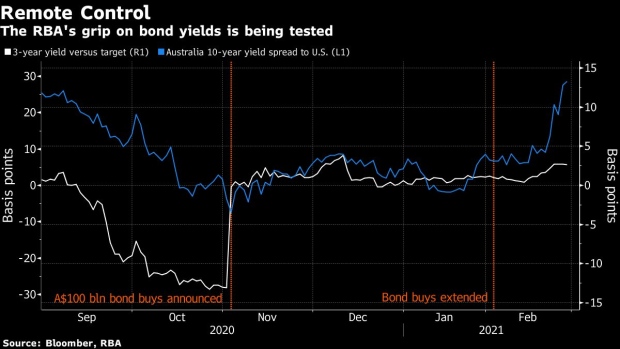Feb 24, 2021
RBA Boosts Defense of Yield Target With A$3 Billion Purchase
, Bloomberg News

(Bloomberg) -- Australia’s central bank dived back into the market for three-year bonds for a second time this week as bets on a new commodities supercycle and global inflation push yields above its target.
The yield edged closer to the 0.1% target after the Reserve Bank of Australia announced on Thursday that it would buy A$3 billion ($2.4 billion) of securities maturing April 2023 and 2024. Purchases of A$1 billion on Monday had little impact amid a tide reflation trades across global interest rate markets.
The central bank also said it will purchase A$2 billion of November 2028 to November 2031 securities under its quantitative easing program. At a total of A$5 billion, today’s purchases match the record level set in March last year when the RBA began buying bonds.
The RBA has ended a two-month hiatus in yield-control operations as investors increasingly doubt it will follow through on forward guidance to hold borrowing costs at current levels further into 2024. The skepticism has been highlighted by the unraveling of a popular trade based on selling April 2024 bonds and buying November 2024 notes in anticipation that the RBA target will shift to the later maturity debt.
The yield on the three-year government bonds edged down slightly in response to the announcement to trade at 0.129% at 11:54 a.m. in Sydney. The Australian dollar tracked similarly to buy 79.63 U.S. cents.
Read More: When Listening to the Central Bank Goes Wrong
While policy makers are trying to push back, traders are emboldened by Australia’s rapid economic recovery, as the country suppresses Covid-19 and massive fiscal and monetary stimulus encourages households to spend and firms to hire. A further boost has come from the surging price of iron ore, Australia’s largest export, which crashed through $170 a ton this week and is closing in on a record.
The challenge to policy makers in Australia is shared by counterparts from Europe and the U.S. Federal Reserve Chairman Jerome Powell signaled Tuesday that the U.S. central bank was nowhere close to pulling back on its support for the U.S. economy, even as he voiced expectations for a return to more normal, improved activity later this year.
Lowe himself is skeptical about any rapid recovery in inflation. He has noted that before the pandemic, when unemployment had a 4 in front of it in some Australian states, yet it still failed to generate the sort of wage gains that would be needed to return CPI sustainably to the RBA’s 2-3% target. Australia’s most recent annual inflation reading was just 0.9% and the jobless rate currently stands at 6.4%.
(Updates with market reaction in fifth paragraph.)
©2021 Bloomberg L.P.


